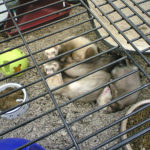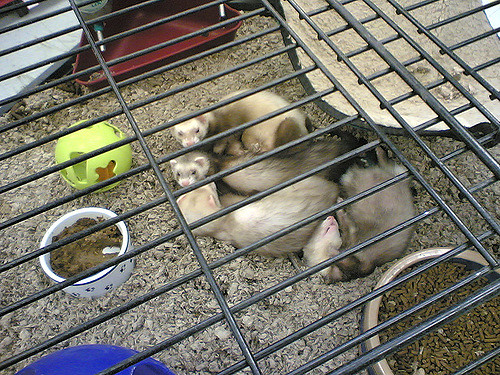As an Affiliate, I may earn from qualified purchases.
Routine cage cleaning is necessary to keep your ferret healthy and safe. It provides an enjoyable, odor-free, and attractive showplace for your enjoyment.
Cleaning products
BRUSHES –
Medium and small sizes depending on your cage. A toothbrush is good for corners and crevices in cage accessories.
BACK-UP CAGE OR PLAYPEN –
A clean environment for the hours or minutes your ferret must be relocated.
RUBBER GLOVES AND GOGGLES
SPONGES –
1 set for cleaning, one for rinsing, and one for disinfecting.
Disinfectants
Selecting the proper disinfectant for cages must be done carefully. The disinfectant must be strong enough to kill disease-causing viruses, bacteria, and fungi, yet not cause harm to the ferret. It is generally best to move your ferret to another room while using most disinfectants.
There are many disinfectants on the market, the most readily available disinfectant for cleaning a cage is household bleach. Use bleach at a dilution of approximately 1 part bleach to 32 parts water (1/2 cup bleach to 1 gallon of water). Other disinfectants safe for your ferret may be available from your veterinarian.
It is important to remove food, feces, soaps, etc., before using any disinfectant since the presence of organic material will prevent it from working properly. Clean any soiled areas of the cage or its accessories with a hot solution of dishwashing liquid, rinse well, then apply the disinfectant.
Apply the disinfectant liberally to the cage and accessories. Rinse the items, especially any wooden items, thoroughly with clean water to remove all the disinfectant. Allow the cage and all items to dry thoroughly before reassembling and placing your ferret back into the cage.
Ferret cage.
Cleaning tools
Assemble a cleaning kit expressly for cleaning the cage. Store these items separately from your other household cleaning supplies. To prevent cross-contamination, never use sinks or tubs that are used for human bathing or food preparation.
BUCKETS
PAPER TOWELS OR CLEANING CLOTHS
Q-TIPS, TOOTHPICKS, PUTTY KNIVES, AND RAZOR BLADES –
Needed to reach into the smallest of spaces, and remove any hardened material.
DISINFECTANT –
Such as diluted bleach (see below).
Cleaning schedule
In general, you will need to perform:
During cleaning procedures, it is recommended to use rubber or latex gloves and protective goggles. After every cleaning procedure – no matter how large or small – wash your hands thoroughly; you may also wish to use a hand sanitizer.
Weekly cleaning and disinfecting of the cage and accessories.
Daily cleaning to remove spills, uneaten food, urine or feces; also clean and disinfect food and water dishes.
Daily cleaning
As you clean, it is important to look for any signs that your ferret may be ill. Watch for hazardous conditions in the cage, and remove or correct them. Observe:
Has a normal amount of food been eaten?
Is the temperature of the cage within the proper limits?
Are the feces and urine normal in appearance and quantity?
Is there any evidence of parasites?
Do any of the accessories appear frayed or need to be replaced?
Is the cage in good repair?
Relocate your ferret to another clean cage until the cage is free and dry of fumes if you deem it necessary to clean the inside the cage with a cleaning solution.
To provide more cleaning power, use a disinfectant. Always rinse well to be sure no trace of soap or disinfectant remains on the dishes. A good alternative is to have two or more sets of dishes, so while one set is being cleaned, the other set can be used in the cage.
Food and water dishes should be washed in hot, soapy water, and dried thoroughly. If you use a water bottle, use a bottlebrush to clean it thoroughly.
Daily, remove uneaten food, wipe up water spills and remove wet spots or waste in bedding and litter. Change any bedding or litter that is too soiled if necessary.
Routine weekly cleaning
Once a week, relocate your ferret to a clean cage or playpen, then
Clean all cage surfaces with soap and hot water, and rinse well.
Wash and disinfect any cage accessories, such as climbing shelves, beds, or toys, per the manufacturer’s cleaning instructions for each product. Rinse thoroughly and dry well.
Wash your hands with hot, soapy water.
Provide the appropriate amount of bedding and litter. Re-install accessories.
Loosen tough spots with a toothbrush, or putty knife.
Allow the cage and accessories to dry thoroughly before reassembling to reduce the possibility of mold.
After rinsing the cage and washing and accessories, use a disinfectant. Be sure to rinse the cage and accessories with hot water until all residues are removed.
Assemble a cleaning kit expressly for cleaning the cage. There are many disinfectants on the market, the most readily available disinfectant for cleaning a cage is household bleach. Apply the disinfectant liberally to the cage and accessories. Allow the cage and all items to dry thoroughly before reassembling and placing your ferret back into the cage.
A good alternative is to have two or more sets of dishes, so while one set is being cleaned, the other set can be used in the cage.
Remove all decorations in the cage.
Clean, rinse, and disinfect water bowls (or bottles) and food bowls, as above.
Be sure to thoroughly clean and disinfect all equipment, sponges, buckets, gloves, and sinks.
Bag and discard disposable bedding and litter.







Comments are closed, but trackbacks and pingbacks are open.